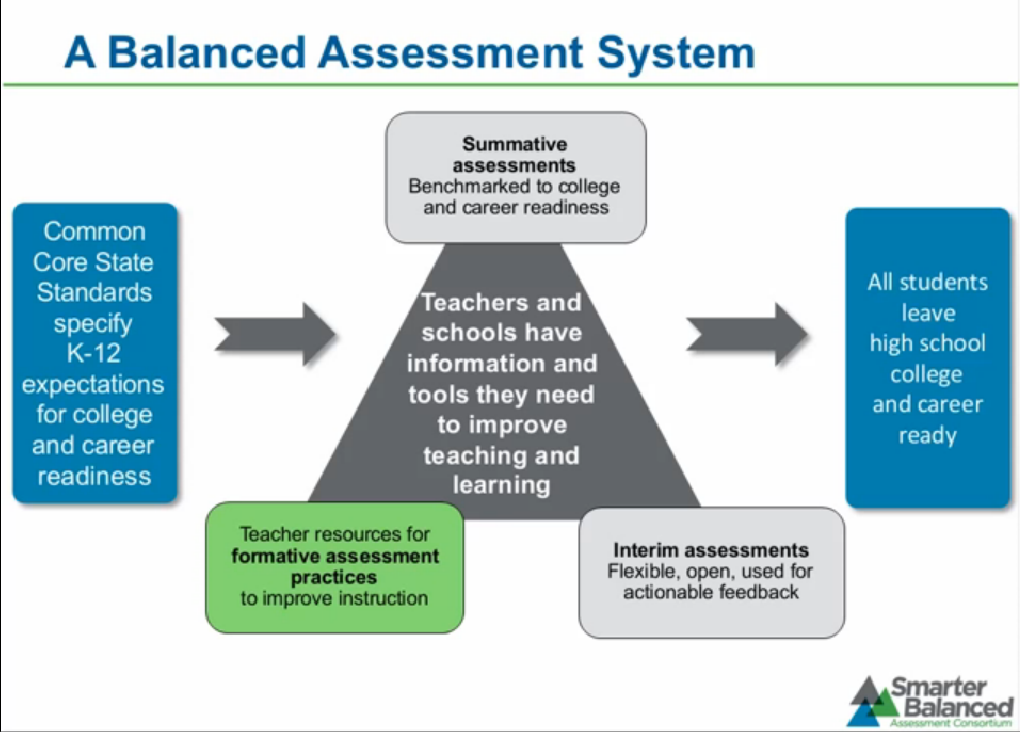3.2 Introduction to Next Generation Assessments
What are Next Generation Assessments?

Overview
The Next Generation Assessment system—including summative, interim, and formative components—is designed to accurately measure student achievement and growth toward college- and career- readiness.
Assessment System Components (from SBAC)
- A summative assessment administered during the last 12 weeks of the school year.
- The summative assessment will consist of two parts:
- a com**r adaptive test and
- performance tasks that will be taken on a com**r, but will not be com**r adaptive.
- The summative assessment will:
- Accurately describe both student achievement and growth of student learning as part of program evaluation and school, district, and state accountability systems; Provide valid, reliable, and fair measures of students’ progress toward, and attainment of the knowledge and skills required to be college- and career-ready; and Capitalize on the strengths of com**r adaptive testing—efficient and precise measurement across the full range of achievement and quick turnaround of results.
- The summative assessment will consist of two parts:
- An interim assessment is administered at locally determined intervals.
- These assessments will provide educators with actionable information about student progress throughout the year. Like the summative assessment, the interim assessments will be com**r adaptive and includes performance tasks.
- The interim assessments will:
- Help teachers, students, and parents understand whether students are on track, and identify strengths and limitations in relation to the Common Core State Standards; Be fully accessible for instruction and professional development (non-secure); and Support the development of state end-of-course tests.
- Formative assessment practices and strategies are the basis for a digital library of professional development materials, resources, and tools aligned to the Common Core State Standards and Smarter Balanced claims and assessment targets.
- Research-based instructional tools will be available on-demand to help teachers address learning challenges and differentiate instruction. The digital library will include professional development materials related to all components of the assessment system, such as scoring rubrics for performance tasks.
These assessments will go beyond traditional methods such as multiple choice - to include performance tasks that allow students to demonstrate research, writing, and analytical skills. The assessments are designed to give teachers the feedback they need to guide instruction, and the tools to improve teaching and learning.
In addition to a year-end summative assessment, Next Generation Assessments will include optional interim assessments that allow teachers to measure student progress throughout the year. Results from the interim assessments will provide a better understanding of each student’s strengths and weaknesses. Teachers will have the flexibility to access student results and supporting resources as needed through a secure, online system.
Com**r Adaptive Testing
The Next Generation Assessment system capitalizes on the precision and efficiency of com**r adaptive testing (CAT) for both the mandatory summative assessment and the optional interim assessments. Based on student responses, the com**r program adjusts the difficulty of questions throughout the assessment. For example, a student who answers a question correctly will receive a more challenging item, while an incorrect answer generates an easier question. By adapting to the student as the assessment is taking place, these assessments present an individually tailored set of questions to each student and can quickly identify which skills students have mastered. This approach represents a significant improvement over traditional paper-and-pencil assessments used in many states today.
- To learn more about Com**r Adaptive Testing, click here (optional).